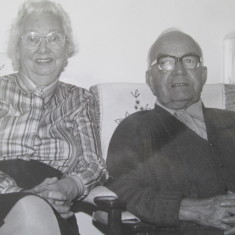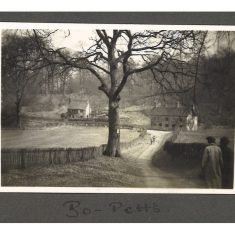Evocative glimpses of life in a Knole Estate cottage in the early decades of the 20th century: one cold tap in the kitchen; no electricity; boiling kettles on a wood fire; heating hot water in a large copper for a bath in an outdoor shed. Village life was fun, with many friends and happy times on Boxing Day in the Great Hall at Knole. Emmy also recalls her father’s work as a Knole Estate fencer. Strictly no work on Sundays; walking for miles to Stone Street or Seal Chart.
Emmy Arlett
Knole Estate Fencer's daughter, grew up in estate cottage in the 1910s and 20s
Interviewed by Wendy Ferguson in 1988
No electricity; copper for hot water in outdoor shed
EA: No, no electricity, no gas, nothing. Not for years, till I was grown up anyway and the others had all gone. And just had to cook with wood on a kitchener, and the copper was in the corner – they had to boil that up. My father used to get up early on Monday and light the copper and fill it up, ready, to boil up the washing and do it. No washing machines, only a scrubbing board and a mangle. [laughter]
Interviewer: You were telling me then about the copper in the shed?
EA: Yes, well then, they, years afterwards, that was when I was grown up, they brought this old, the baths from Knole that were turned out – enormous bath it was and they put it in this – they cemented the shed floor, and they put the copper out there in the corner and built the chimney through the top, and then they put the bath in there as well. And we used to boil the copper and ladle the water from the copper into the bath before we had a bath. And when the bath water ran away there was no drain for it to go to, so it had a pipe laid under the ground into the wood and it just soaked away out into the wood. And that was how we had a bath. Before that we had a tin bath in front of the fire.
Heating hot water, candles and hot bricks to bed
Interviewer: Because presumably every bit of hot water had to be heated by wood?
EA: Yes, because in the kitchen, in the corner of the kitchen was a sink, like a stone sink and only one tap you see, just a cold tap, that’s all. If you want a cup of tea, you’ve got to boil it on the stove you see. The kettles were always there. Big kettles on the stove, they were always there, to keep the water hot. But we used to, no hot water bottles or electric blankets you see, we used to have a house brick put in the bottom of the oven, and then put into an old sock when we went to bed and that was our hot water bottle. All very primitive today, isn’t it?
Interviewer: How about lighting? What did you use for lighting?
EA: An oil lamp, paraffin lamps, and candles to go to bed. And, because we didn’t know any different, you see. So, it was alright.
Interviewer: When was electricity eventually installed?
EA: Well, I was grown up and working. So, I don’t really know, I suppose, I was 15 when I started to work, so I must have been 20 then when it was put on. Perhaps older than that.
Father's work as a fencer
Interviewer: Tell me about your parents. Your father was Fencer?
EA: Yes, he used to make all the fences. Sawing up the log, the wood from the tree trunk. They used to put it across the saw pit, in the woods and saw it through. Mr Botten was the other man, and my father was Mr Sales. And they used to – one in the bottom of the pit and one at the top and they had this huge saw, and they used to saw it by hand, right through the tree trunks and make the strips of wood and then make the fences and the gates, you see? But after, you know, years after, they had a sort of a steam saw at Knole. It was just as you go into the Stable yard – I don’t know if it’s still there, but it had a place there – then the tree trunks used to go there and be sawn through, come to them in long, flat pieces and they used to do it from that.
But they used to put all the fences up and hang all the gates on the estate. And the wooden fence that used to be all round the park – that was their work. They used to do it and put it up. I think they used to go to work about half past six in the morning, in the dark in the winter, and come home in the dark. It was a hard life, I suppose, but then it was their job, and they did it.
Interviewer: And constant work, the fencing, I should think? I can’t imagine how many miles of fencing it must have involved.
EA: Well, the park is supposed to be seven miles round, isn’t it? It comes along in the park, by Webbs Alley all along there and then it joins up again on the Tonbridge Road and goes right round to Fawke Common right down into Godden Green, you see, and round that way. But some of the fencing wasn’t solid, it was just like posts and rails, in Blackhall Lane when it went along there. It was like posts and rails; it wasn’t solid but it was a full-time job to do it. And there’s lots on the farms out at Stone Street, that belonged to Knole. They used to do the fencing there. But that was like chestnut fencing, they used to do it with a wire: put the stakes in and then twist the wire round it, the chestnut fencing. But they used to do it with weights somehow and they’d do the twisting with the wire.
No work and long family walks on Sundays
Interviewer: And that was working, what, six days a week?
EA: Yes, they used to work full six days a week, then when I was, I don’t know how old I would have been, perhaps about 12 or something, because I were the youngest of the family. Then they started coming home at lunchtime on Saturdays, so they had a half day on Saturdays and of course, Sundays they never worked. Those days, nobody was allowed to do anything on Sunday. No washing out, my father was very strict. He would have nothing like that. And he didn’t do anything on Sunday; he’d get up in his best clothes whether he was going out or not – and he would light the fires, and help do the vegetables for lunch, and he would do nothing else. All day. And nobody else would. And if the weather was right, we were all, used to have to go for a walk, miles we used to go. I used to like it really, and other people used to join us sometimes. We used to go a long way, to Stone Street and Seal Chart, and think nothing of walking all that way. Well, there was no other way to get there if you wanted to go, you know. But it was a good life, I think.








No Comments
Add a comment about this page